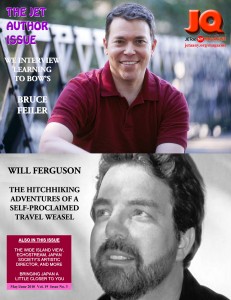JQ Magazine: Book Review – Haruki Murakami’s ‘1Q84’

“Murakami’s previous books were like delicious sandwiches that left you wanting more. 1Q84 is like a two-foot long sub that filled you to bursting, but you’re still not totally satisfied.” (Vintage International)
Roland Kelts, don’t kick me in the balls—
One man’s attempt to review a book honestly while still keeping friends
By Rick Ambrosio (Ibaraki-ken, 2006-08) for JQ magazine. A staple of the JET Alumni Association of New York (JETAANY) community, Rick manages their Twitter page and is an up-for-anything writer.
My girlfriend wouldn’t shut up about it.
“1Q84 is the best! Ah, when it comes out in English you need to read it!” Just talking about it made her rush to find her old copies (it was broken up into three books in Japan) and start reading them again. She was enthralled, to say the least. I’ve been a Murakami fan for a while: Norwegian Wood was emotional and sexually riveting; Dance Dance Dance was creepy as hell but lots of fun; Kafka on the Shore blew my mind. So I was hungry for 1Q84.
I picked it up shortly after it came out…and put it down for a while…then picked it up again…then down… then up…I think you get the idea. My feelings can kind of be summed up like this: Murakami’s previous books were like delicious sandwiches that left you wanting more. 1Q84 is like a two-foot long sub that filled you to bursting, but you’re still not totally satisfied.
The plot follows two people tied together by fate, love, and inter-dimensional happenstance. Tengo is an author and math teacher who finds himself embroiled in a shady plot to write an award-winning book. Aomame is a fitness instructor with a decidedly darker side job. Both find themselves in an altered version of 1984 called 1Q84 that deviates from the previous reality in specific ways. Those changes seem to revolve around a cult, a beautiful young girl, a book and mysterious “Little People.” Their battle to beat the odds and find each other, discover where they are, and who’s behind the changed world is an epic journey told through alternating perspectives.
1Q84 had all the things I love about Murakami: Super complex, interesting and engaging characters, crazy inter-dimensional sex, lots of mystery, and supernatural elements that bring it right on the cusp of reality, teetering between a fantasy realm and the real 1984. His ability to walk that line (like a cat walking a picket fence for those who love cats not only in Murakami novels, but also in reviews of Murakami novels) is astounding and he does it…for a really long time.
JET alum Bruce Feiler’s latest NYTimes column on Maria Popova, creator of Brain Pickings
Here’s the latest NYT column by JET alum Bruce Feiler (Tottori-ken, 1989-90), author of Learning to Bow, The Council of Dads, and, most recently, The Secrets of Happy Family, as well as several books on the Middle East including Walking the Bible, Abrahamand Where God Was Born. To read prior columns, please click here.
This Life: She’s Got Some Big Ideas
By Bruce Feiler
SHE is the mastermind of the one of the faster growing literary empires on the Internet, yet she is virtually unknown. She is the champion of old-fashioned ideas, yet she is only 28 years old. She is a fierce defender of books, yet she insists she will never write one herself.
CLICK HERE to read the full column.
JQ Magazine: Concert Review – ‘The Legend of Zelda: Symphony of the Goddesses’

“There was so much attention paid to the nuance, so much consideration given to the fans, that the show became a kind of homage to both the franchise’s legacy and to every avid gamer whose collective fealty raised Zelda into one of the highest echelons of video game lore.” (Preston Hatfield)
By Preston Hatfield (Yamanashi-ken, 2009-10) for JQ magazine. Preston moved from San Francisco to New York City in January 2012 and is now accepting submissions from people who want to be his friend. Abduct him from his house in the middle of the night, or find him on Facebook and ask about his JET blog in which he details his exploits and misadventures in that crazy Land of the Rising Sun we all love.
If life is one ongoing adventure and each day is its own side quest, then several days ago the already labyrinthine halls beneath Madison Square Garden were not those of a theater but a dungeon, and the spirited host of attendees was nothing short of raiders in pursuit of plunder. Their coveted treasure on this magical evening of Nov. 28 was The Legend of Zelda: Symphony of the Goddesses from Jason Michael Paul Productions. Wielding the baton like her own personal Master Sword (or, as was the case at the onset of the Wind Waker movement, an actual replica of the Wind Waker), conductor Eimear Noone led the Orchestra of St. Luke’s into an epic musical campaign that toured across Hyrule and the 16 games in Zelda’s renowned platform, which is currently celebrating 25 years since its American debut on the original 8-bit Nintendo Entertainment System.
The evening commenced with a rousing overture in the form of “The Legend of Zelda Medley” before embarking a four-part movement that began with the crowd favorite Ocarina of Time, and concluded with A Link to the Past, the game where many of the now iconic Zelda themes first premiered. Each movement in this symphonic journey—this Tour de Triforce, if you will—began at the beginning of each game and proceeded to tell the familiar tales of heroism and mystic wonder, transitioning almost fairylike from one key moment to the next, as large screens over the orchestra showed in-game footage for context and intermittently focused on soloists and the choir.
JET alum Asia Security Expert Michael Auslin in the Wall Street Journal
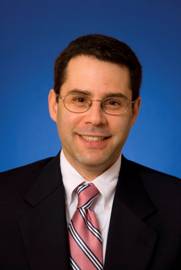 Here’s a recent article in the Wall Street Journal by JET alum Michael Auslin, Director of Japan Studies at the American Enterprise Institute:
Here’s a recent article in the Wall Street Journal by JET alum Michael Auslin, Director of Japan Studies at the American Enterprise Institute:
Michael Auslin: Asian Pivot, Take Two
President Barack Obama is celebrating his re-election by trying to make good on his promised pivot to Asia. Not only is the President in the region for the East Asian Summit in Cambodia—he has also dispatched his Secretaries of State and Defense on extended visits as well.
Showing up may constitute 90% of diplomacy. But at a time of numerous territorial disputes and leadership upheavals, Mr. Obama may have bitten off more than he can chew over the next four years.
The Administration’s agenda this month is an unusual start. Unlike traditional trips that include old allies like Japan or …
Click here to read the article (subscription required).
“Privy to Mysterious Loos” by New Zealand JET Tania Butterfield
A recent blog article by current JET Tania Butterfield that recently appeared in New Zealand publication Marlborough Express. (Thanks to Jessica Tisch for posting on the JETAA South Island Facebook group):
Last weekend I discovered something I should have known since I arrived here – toilets are not my friend.
If you know anything about Japan, you know it has some unusual toilets.
No, I am not referring to the squat toilets, which I quite happily use at school.
I am referring to the insanely automated toilets with a billion buttons that do everything under the sun so you never have to touch that part of your body again.
Some of the buttons make sense – like the button to ….
Click here to read the full article.
JQ Magazine: Book Review – ‘Professor Risley and the Imperial Japanese Troupe: How an American Acrobat Introduced Circus to Japan—and Japan to the West’
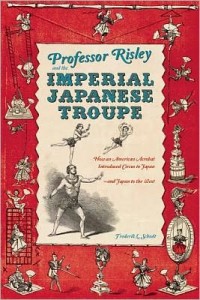
“Chock-full of illuminating illustrations and gorgeous printed ephemera that would make any contemporary typographer swoon, Professor Risley and the Imperial Japanese Troupe is a jet-set adventure in pop culture scholarship sure to appeal to anyone interested in Japan’s history on the world stage.” (Stone Bridge Press)
By Jessica Sattell (Fukuoka-ken, 2007-08) for JQ magazine. Jessica is a freelance writer, and was previously the publicist for Japan-focused publishers Stone Bridge Press and Chin Music Press. She is interested in the forgotten histories of culture, and has often considered running away and joining the circus.
We’re still riding the “Cool Japan” wave that crested at the turn of the millennium, but our fascination with the country and its culture didn’t quite stem from just anime, Harajuku fashions, or J-pop. In Professor Risley and the Imperial Japanese Troupe: How an American Acrobat Introduced Circus to Japan—and Japan to the West, award-winning author Frederik L. Schodt argues that contemporary interest in Japan’s popular culture has its roots in the travels and cross-cultural interactions of a band of 19th century Japanese circus performers and a colorful American impresario.
Published in November by Stone Bridge Press, Professor Risley explores a critical and exciting time in history, when an interest in foreign cultures was rapidly expanding beyond the privileged parlors of the upper class and Americans and Europeans were greatly fascinated by anything Japanese. Schodt offers an intriguing case study of both early Japanese conceptions of the West and the West’s first looks at modern Japan, but it is also a mystery of sorts: Why did a group of acrobats that were incredibly popular with international audiences in the 1860s fade from the annals of performing arts history? How was the life of “Professor” Richard Risley Carlisle, arguably one of the most extraordinarily talented and well-traveled performing artists in history, buried in the folds of time? Schodt suggests that we may never know the answers, but we can sit back and enjoy the show as their histories unfold.
This story begins, fittingly, with the question, “Where Is Risley?” Schodt artfully traces “Professor” Risley’s early travels and performance history like an elusive game of connect-the-dots, piecing together itineraries, publicity notices and press clippings until a clear pattern of a fascinating life emerges. Risley seemed to be everywhere and nowhere, and led a full life of jet-setting and adventure-seeking at a time where transcontinental travel was only beginning to open up to those outside of the diplomatic realm. We follow him on a decades-long journey across the United States, Europe, Australia, New Zealand, Southeast Asia, China…and finally to Japan.
Risley arrived in Yokohama in early 1864 and immediately went to work setting up a fantastic Western-style circus to delight foreign residents and Japanese locals alike. As the country had re-opened to the world just five years earlier, it was a risky time to be in Japan, and non-Japanese residents lived with underlying worries of Shogunate-dictated expulsion and violence from disgruntled ronin. That didn’t quite stop Risley’s entrepreneurial spirit, but he did eventually run into a series of difficulties with his shows—and a stint in dairy farming, which, in the process, led him to introduce ice cream to Japan. He hadn’t originally intended to stay in Japan for long, but most likely due to the Civil War raging back home in America, he bided his time and explored his options. Thankfully, his stay there—paired with an almost desperate talent for improvisation—would lead to the world’s first taste of Japanese popular culture.
JQ Magazine: JQ&A with Matthew Gillam, Senior Researcher at the Japan Local Government Center

“When you come back from Japan, people say, ‘You know Japanese, you’ve been abroad, you should be able to get a job anywhere.’ You soon realize that it doesn’t work that way. Alumni coming back should look at things you did in different light: what did you fundamentally do, and take away from that?”
By Adam Lobel (Nagano-ken, 2000-02) for JQ magazine. Last year, Adam returned to New York after 10 years in Japan, where he researched satoyama (traditional landscape of Japan) as a master’s student, and collaborated with Japanese policymakers in science and technology while working at a think tank. Adam currently helps manage his family’s business, a land use law firm in Manhattan, and looks forward to contributing to New York’s green building movement.
Born and raised in Marshalltown, Iowa, Matthew Gillam was hooked on Japan after visiting when he was 17. After college, he lived in Japan for eight years, and then returned to the U.S., where he completed a master’s at Columbia’s School of International and Public Affairs (SIPA). Matt has spent the past 14 years as a researcher at the Japan Local Government Center (JLGC), discovering and sharing best practices from local governments in North America with his colleagues in New York and Japan.
By encouraging organizational discipline and providing tools to build strong networks, Matt has helped strengthen the JET Alumni Association, thus helping thousands of JET participants smoothly transition to life back home. He promotes JETAA’s role an important stakeholder in productive business and cultural relationships with Japanese localities, helping broaden the JET Program’s mission long after participants return home.
In this thought-provoking interview, JQ spoke with Gillam about what it was like to study Japanese at the University of Iowa in the 1980s, life in Japan before the existence of JET, and the kindness and hard work JET families displayed in the aftermath of 3/11. He emphasizes that JET—an experiment in grassroots internationalization—has changed how the world thinks about Japan. Matt gave this interview before heading to Japan, where he spent four days with It’s Not Just Mud (INJM), a non-profit volunteer organization based in Ishinomaki.
How did you become interested in Japan?
I was exposed to Japan when I was seven: my sister spent the summer of 1969 as an exchange student in Yamanashi. She fell in love with Japan, and told us about it after returning home. Eventually she went to live in Japan, teaching English at Sony Language Labs. In 1979, just before my senior year of high school, my mother and I went to visit. Before that trip, I never liked to travel. Suddenly, I was in a completely new place. I realized there was a bigger world, and it was interesting. That’s when I fell in love with Japan, its people, food, art and architecture.
After my sister returned to the U.S., she placed a Japanese student in a nearby town. I fell in love with that student, who eventually became my wife. In college I flunked out of forestry, my first major and, looking for something new, got into Japanese language. I did a year abroad at Kansai Gaidai in Osaka, and spent eight more years in Japan after graduating.
How did people react to your decision to study Japanese? What was Japanese study like at the University of Iowa in the 1980s?
Some people did not understand my decision to study Japanese, especially because it was a small Midwestern town. Their reaction was, “Why Japanese?” This was 1982: Japan was just beginning to emerge as a major economic rival, and Japanese culture hadn’t permeated the Midwest yet. It was a strange thing to do.
My sister understood, and my mom understood, but other family members and friends did not. In those days, some people’s reaction to Japan was still influenced by the Second World War: “These people were enemies; I am not comfortable with them.” That only got worse through the eighties with trade friction.
Study materials were primitive by today’s standards: Japanese textbooks by Prof. Eleanor Jorden, a kanji dictionary, and language lab with cassette tapes. Our professor, Thomas Rohlich (now at Smith College) started the same day I did. We had a Japanese teaching assistant from Tokyo, but most of the teachers were white men.
There were no Japanese restaurants or pop culture. Fisher Control, a company in my hometown, employed a Japanese engineer, who had relocated with his wife. At the beginning of my first year of college, there were 30 students, the biggest class they had ever had! That number slowly decreased, until there were only six or eight students by my third year. There were a couple of Japanese students on campus who became casual friends. Prof. Rohlich’s wife was from Kyoto, and she hosted a gyoza party. That was about it.
Justin’s Japan: Interview with Tera Patrick at Exxxotica Leads to ‘Happy Ending’
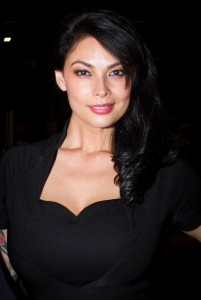
“My first modeling job at the age of 13 was in Omotesando in Tokyo. So I’ve always been obsessed with Japanese culture, and I usually spend one month of the year in Japan. I love everything about Japan.” (Courtesy of Justin Tedaldi)
By JQ magazine editor Justin Tedaldi (CIR Kobe-shi, 2001-02) for Examiner.com. Visit his Japanese culture page here for related stories.
Interview conducted by Rick Ambrosio (Ibaraki-ken, 2006-08). A staple of the JET Alumni Association of New York (JETAANY) community, Rick manages their Twitter page and is an up-for-anything writer for JQ magazine.
From porn to Playboy to parenthood, Tera Patrick describes herself these days as a “Betty Crocker Rocker Mompreneur.” Suitably following Hurricane Sandy at this year’s Exxxotica Expo in New Jersey—the nation’s biggest event devoted to love and sex—this multi-award-winning force of nature attended the three-day fest from Nov. 9-11 to press the flesh with fans and read from her best-selling autobiography, 2010’s Sinner Takes All.
But here’s something you might not know: Patrick’s been a diehard fan of Japanese culture since her days in Tokyo as a teen model. In this exclusive interview, the Montana native dishes on Harajuku girls and yakuza tats, the controversial Measure B that could forever change the adult industry, and the upcoming sequel to Sinner Takes All.
How are you enjoying Exxxotica?
I’m enjoying Exxxotica a lot—it was really important for me to come back. This is my first time at the show; I haven’t been back here since 2009. And in light of Sandy, it was really important to give back and boost morale and donate Tera items. I’m doing care packages for veterans tomorrow.
Last month you were a special guest at New York Comic Con. How did that end up happening?
You know what’s funny? I always say guys like three things: they like porn, comics and chicks. So it wasn’t too farfetched for me to be there; I actually debuted my first show at Comic Con in 2007 when I appeared in the video game Saints Row. So I’ve been in video games, I’ve had the privilege of being on Adult Swim and Aqua Teen Hunger Force, I’ve done adult. I do a lot of different things—I’m an author now. My first memoir was Sinner Takes All; my second follow-up memoir comes out February 2013.
We heard that for Halloween your outfit was a Harajuku girl. Is that true?
Yes. I’m actually very fascinated by Japanese culture. In my memoir Sinner Takes All, my first modeling job at the age of 13 was in Omotesando in Tokyo. So I’ve always been obsessed with Japanese culture, and I usually spend one month of the year in Japan.
Japan still is my favorite country to visit. I love Japanese food. I’m Thai—my mother’s from Thailand—but I love Japanese food, Japanese culture. I love everything about Japan, so I’m really excited to take my family there for the first time in December. So I’ve been a bit selfish, and I always spend a lot of time in Japan. I’ve been tattooed in Japan; I’ve only been tattooed in Japan.
For the complete interview, click here.
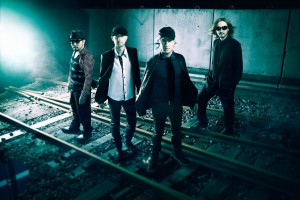
Maynard Plant, second from left: “I really do think it is important to learn more than one language. Not only for the obvious convenience of communication, but for the enrichment of understanding of other cultures as well. Language really is the only gateway into understanding another person’s psyche and culture.” (Courtesy of Edward Entertainment Group)
By Preston Hatfield (Yamanashi-ken, 2009-10) for JQ magazine. Preston moved from San Francisco to New York City in January 2012 and is now accepting submissions from people who want to be his friend. Abduct him from his house in the middle of the night, or find him on Facebook and ask about his JET blog in which he details his exploits and misadventures in that crazy Land of the Rising Sun we all love.
Multinational pop rockers Monkey Majik are teaming up with shamisen heroes the Yoshida Brothers, the duo known for their traditional sound and pluck, for a three-date North American tour that kicks off Nov. 14 at Manhattan’s Marlin Room at Webster Hall, followed by the Mod Club in Toronto Nov. 18 and the National Arts Centre in Ottawa Nov. 20.
Monkey Majik was founded by Maynard Plant (Aomori-ken, 1997-2000), a native of Ottawa, Canada, while he was teaching English in Sendai on the JET Program. Known for a having a fun and versatile style of music, the band first earned mainstream attention in 2006 for their singles “Fly” and “Around the World,” and have since collaborated with other Japanese groups like SEAMO, m-flo, Bennie K, and the Yoshida Brothers.
In this exclusive JQ interview, the versatile vocalist and guitarist discusses the band’s origins, his own relationship with music, and his sense of home and community in Sendai, which is still recovering from the devastation caused by the 3/11 earthquake and tsunami.
Which came first: the love of music or Japanese culture, and how has the one influenced and supported the other since you came to Japan?
I probably first took interest in Japan when I was about 10 years old or so when I visited Expo 86 in Vancouver, Canada. My interest in music also started at an early age. Most of my family is musical, so it always came natural. Certainly since arriving in Japan about 15 years ago, my musical interests have changed. The Japanese music scene is incredibly diverse and different from the Western scene. The sound is very unique and [it] has had a deep effect on our music.
It’s funny, many ALTs in Japan feel like rock stars, but you actually became a rock star. What was it like going from small time notoriety and fame at your school, to becoming famous on a national level for your musicianship?
It didn’t happen overnight, so I suppose I never took notice. It’s a lot like learning Japanese—you don’t just wake up fluent one day. Success is born out of hard work and commitment. Regardless of where you live, the same elements come into play.
How did the current band members come together? Were you friends before you started collaborating professionally? How have each of you influenced Monkey Majik’s sound, style, and group dynamic?
I put the current band together after most of the original members quit in 2000. I first called my younger brother Blaise, and within a couple of months we found Tax (Kikuchi Takuya). It was around 2005 that our original bassist Misao Urushizaka quit. We then recruited Dick (Hideki Mori). It’s difficult to say if the friendship came before membership, but one thing is certain now: we wouldn’t be doing this if we hadn’t become best friends. We have a lot of respect for each other and all [band] decisions are made together.
Justin’s Japan: A Whole Month of Arts, Events, Music
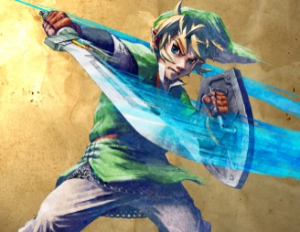
The Legend of Zelda: Symphony of the Goddesses comes to the Theater at Madison Square Garden Nov. 28. (Jason Michael Paul Productions)
By JQ magazine editor Justin Tedaldi (CIR Kobe-shi, 2001-02) for Examiner.com. Visit his Japanese culture page here for related stories.
Hurricane Sandy may have wreaked havoc on the Eastern Seaboard, but New York is holding strong in November with a bounty of Japan-related events from MoMA to Madison Square Garden.
Nov. 6
Nausicaä of the Valley of the Wind Box Set
Nausicaä of the Valley of the Wind is an epic fantasy tale written and illustrated by legendary Studio Ghibli director Hayao Miyazaki, creator of My Neighbor Totoro, Spirited Away, Howl’s Moving Castle and Ponyo. A modern masterpiece (made into its own classic film adaptation in 1984), the entire series is now available in this deluxe box set containing two hardcover volumes with interior color pages and full-color double-sided poster in a special slipcase.
Nov. 9-11
The American Dream Japanese Network (JaNet) was originally created in 2001 following the 9/11 attacks to cheer up and unite the Japanese community, which lost many of its prominent members working in the World Trade Center. An annual Japanese music and performing arts showcase, this year’s three-night event features such diverse acts as Taka Kigawa, Taiko Masala, and Yosakoi Dance Project – 10tecomai, last year’s Talent Night winners!
Monday, Nov. 12
Geisha: The Golden Years 1870-1890 Opening Reception
This Long Island City gallery is proud to present an exhibition of 19th century hand-colored photographs of Geisha and Maiko from the Burns Archive. These photographs are the original images used by Dr. Stanley Burns and his daughter Elizabeth to create their noted book, Geisha: A Photographic History 1872-1912. The images in this exhibition showcase the best of Japanese photographs that were made to show the perceived exotic nature of Japan to the West. Several of the great early photographers’ studios are represented, including Kusabi Kimbel, Ogawa Kazumasa and Baron von Stillfried.
For the complete story, click here.
By JQ magazine editor Justin Tedaldi (CIR Kobe-shi, 2001-02) for Shukan NY Seikatsu. Visit his Examiner.com Japanese culture page here for related stories.
The opening of playwright Jeanne Sakata’s Hold These Truths begins with the famous United States Declaration of Independence quote that all men are created equal, followed by the Japanese proverb “the nail that sticks up gets hammered down.” The one hammered down is Gordon Kioyoshi Hirabayashi, the late American pacifist and Presidential Medal of Freedom honoree whose experiences in World War II-era America are brought vividly to life by Joel de la Fuente in this one-man show now running Off-Broadway.
“From the day rehearsing began for our premiere in November 2007, we’ve been working to make Hold These Truths a better play, and that hasn’t stopped with our New York premiere,” said Sakata, who shaped it through extensive interviews with Hirabayashi. The play has received positive reviews from The New Yorker and the Associated Press, and has brought wider attention to a traumatic time in American history.
Born in Seattle in 1918, Hirabayashi was imprisoned in 1942 for protesting wartime curfews. He lost a U.S. Supreme Court case the following year, but the verdict was later overturned in the 1980s, triggering an apology and reparations to the families of the more than 100,000 people interned in the western United States during the war.
Hold These Truths runs through Nov. 25 at the Theater at the 14th Street Y. For more information, visit http://epictheatreensemble.org/holdthesetruths.
JQ Magazine: 2012 JETAA National Conference in San Francisco Recap
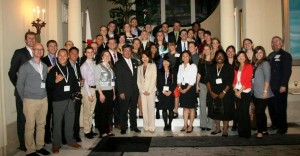
JETAA USA delegates at the residence of Ambassador Hiroshi Inomata, Consul General of Japan in San Francisco, Oct. 26, 2012.
By Pam Kavalam (Shiga-ken, 2007-09) for JQ magazine. Pam is Secretary of the JET Alumni Association of New York (JETAANY) and a participant at this year’s National Conference.
Thursday, Oct. 25
Hosted by the JETAA Northern California (JETAANC) chapter, the conference kicked off with a “reception” at Off the Grid, a collection of gourmet food trucks inspired by Asian night markets and conceived and run by JET alum Matt Cohen (Saga-ken, 2001-04).
Friday, Oct. 26
The delegates from 18 of the 19 JETAA USA chapters received a welcome from JETAANC President John Dzida, Consul General of Japan in San Francisco Hiroshi Inomata, and Takaaki Ogata from CLAIR New York. Noriko Watanabe from the Embassy of Japan in Washington, D.C. gave a touching personal farewell from Ambassador Ichiro Fujisaki, who attended the past two JETAA National Conferences and will be leaving his post this year. Workshops topics included sister city-JETAA cooperation; databases and approaches for chapter membership management; and the utilization of Google apps and websites to publicize programs. There was also an update on the National 3/11 Relief Fund, which raised nearly $90,000 from all 19 chapters for Tohoku recovery efforts. The evening ended with a reception at the Consul General’s Residence and continued networking at Local Edition in the Financial District.
Saturday, Oct. 27
The Country Representatives discussed their visions for JETAA in the coming year and introduced the newly formed JETAA USA Advisory Board, which consists of four seasoned JET alums who will provide guidance to all national and regional leadership. It includes James Gannon (Ehime-ken, 1992-94) and Steven Horowitz (Aichi-ken, 1992-94) of JETAANY; Ryan Hart (Chiba-ken, 1998-99) of Pacific Northwest JETAA; and Jessyca Livingston (Hokkaido, 2003-06) of Rocky Mountain JETAA. Other workshops discussed organizing chapter finances; a JETAANC-run high school scholarship program; facilitating cultural exchange through continuing Japanese traditions such as kabuki; and a panel with members of the Northern California community, including JET alums Ken Wakamatsu (Hiroshima-ken, 1996-1998) at Salesforce and Ryan Kimura (Shizuoka-ken, 2004-06) of JCCC Northern California (and the owner of a purikura shop in San Francisco’s Japantown!). The panel discussed how JETAA chapters can form relationships and collaborate with community groups to engage members. The delegates finished the night with a CLAIR reception at Yoshi’s San Francisco and a cable car sightseeing tour.
Justin’s Japan: Interview with ‘Manga! Manga! The World of Japanese Comics’ author Frederik L. Schodt

“I grew up overseas in several different countries, and I’ve always enjoyed different cultures. And for me, that was exactly the way Japan appeared: it was always interesting, and it still is always interesting. There’s always things to learn.” (Courtesy of Stone Bridge Press)
By JQ magazine editor Justin Tedaldi (CIR Kobe-shi, 2001-02) for Examiner.com. Visit his Japanese culture page here for related stories.
Frederik L. Schodt first traveled to Japan in 1965 as a teenager, and since the early ’80s he has written numerous books about Japanese culture both popular and obscure, including the landmark Manga! Manga! The World of Japanese Comics, the first substantial English-language work on the art form. Schodt also has translated a wealth of books and manga series (many by his late friend, the “god of comics” Osamu Tezuka), and in 2009 he was awarded the Order of the Rising Sun, Gold Rays with Rosette for his contribution to the introduction and promotion of Japanese contemporary popular culture.
Out Nov. 13 is his newest book, Professor Risley and the Imperial Japanese Troupe, the true story of “Professor” Richard Risley Carlisle, an American who introduced the Western circus to Japan in 1864, and in turn gave many Americans their first glimpse of the East when he took his “Imperial Japanese Troupe” of acrobats and jugglers on a triumphant tour of North America and Europe, stirring a fascination with all things Japanese that, Schodt says, eventually led to today’s boom in manga and anime.
In part one of this exclusive, wide-ranging interview, I spoke with Schodt about his fascination with the late 19th century, his relationship with contemporary pop culture icons like George Lucas, and the story behind his middle initial, which is colorfully connected to the events of the film Argo.
It’s been more than five years since the release of your last book, The Astro Boy Essays. What else have you been up to since then?
I’ve actually gone through this and done some rough calculations, but it seems to take me about five years between books. I’ve been doing this same sort of thing that I always do, which is a mix of writing books and translating and then also working as a conference interpreter. For different periods, the weight and the ratio changes, but the mix is pretty much the same. And I’ve been working on the book of Professor Risley and the Imperial Japanese Troupe, I guess, for the last two or three years doing research. But it’s been a lot of fun, I have to say—it’s been one of the most fun books I’ve worked on in a long time.
What are some developments in manga/anime/Japanese pop culture in the U.S. that you feel has moved in a positive direction? At the same time, what things are you a bit critical of in the way they were handled?
I think it’s wonderful that a popular culture from another country such as Japan developed such a large fanbase in the United States, and that was a real surprise to me. I always hoped that people would take more notice in Japanese manga and anime, because I thought they were such an interesting manifestation of popular culture that had been long overlooked in the United States. But I never imagined that both of those entertainment media would become so big and so entrenched in the United States in terms of the fanbase, so that’s been wonderful to see.
It seems like the biggest development in recent years has been the cosplay phenomenon—that’s become a real part of the lingo here now.
That’s right. And I think cosplay in the United States is a little different, and in fact I think the whole fandom in the United States has assumed sort of American characteristics, so it’s developing on its own in new directions, and it’s kind of wonderful to see. I go to some of the larger cons every once in a while, and I really enjoy seeing how young people are interpreting this cultural phenomenon developed in Japan, although I have to say that cosplay is really indirectly inspired by the masquerades and the costume competitions that started in the United States in the sci-fi comic book community. So it’s very interesting. It’s this sort of cultural interchange that I’ve always been fascinated by where you have these two countries that are kind of reflecting each other and sending influences back and forth to each other, and interpreting a phenomenon in slightly different ways.
For the complete interview, click here.
JQ Magazine: Theatre Review – ‘Hold These Truths’

“This amazing life story spanning six decades manages to be compressed by playwright Jeanne Sakata into a dense 90-minute performance that both educates and entertains.” (Photo of Joel de la Fuente by Steven Boling)
A nail that stuck out but resisted being hammered down
By Stacy Smith (Kumamoto-ken CIR, 2000-03) for JQ magazine. Stacy is a professional writer/interpreter/translator. She starts her day by watching Fujisankei’s newscast in Japanese, and shares some of the interesting tidbits and trends together with her own observation in the periodic series WITLife.
The intimacy of a stage surrounded by several rows of semicircle seating at the 14th Street Y is the perfect venue for the new play Hold These Truths. This work depicts the life of Nisei (second generation) Japanese American Gordon Hirabayashi, who took it upon himself to defy Executive Order 9066, which led to the imprisonment of Japanese Americans and their families in internment camps during World War II. It is a one-man show starring Joel de la Fuente, who spellbinds the audience with his ease in slipping back and forth between Hirabayashi and the other characters he portrays. The viewer’s proximity to the performer heightens the emotional depths of Hirabayashi’s often troubling, often inspiring tale of belonging and identity.
The play begins by highlighting the Japanese phrase “deru kugi wa utareru,” or “the nail that sticks up gets hammered down,” which Hirabayashi’s parents instill in him when he is young. He internalizes this belief, but at the same time he is aware of actions that seem to go against it, such as his mom taking a case to court when her land rights are violated. He describes a peaceful childhood in Seattle where he plays with other Japanese American friends and attends picnics where their mothers bring food like “onigiri, chicken teriyaki and banana cream pie.” Raised as a Christian, Hirayabashi becomes a religious pacifist when he enters the University of Washington.
Here he stays in an international dorm and meets his first non-Japanese friends, such as his roommate and close friend Howie and his future wife Esther. He becomes involved with the YMCA as campus vice president and tries to get a job with them at the front desk, but ironically is turned down because of his race. When an 8 p.m. curfew is later put in place for the Japanese, Hirabayashi initially complies but then runs back to join his friends studying in the library. This small act of bravery is emblematic of the much bolder resistance that Hirabayashi will show going forward.
JET Alum Will Ferguson Wins Canadian Lit Award
From the Associated Press via the New York Times:
On Oct. 30, celebrated JET alum author Will Ferguson (Nagasaki-ken, 1991-94) won the Scotiabank Giller Prize, a $50,000 Canadian fiction award, for a his novel 419, about a family’s entanglement in a Nigerian email scam.
A kilt-wearing Ferguson pulled out a flask during his acceptance speech and raised a toast to the written word. Presenters included Sex and the City actress Kim Cattrall.
The Giller, which honors the best in Canadian fiction, was created in 1994 by businessman Jack Rabinovitch in memory of his late wife, literary journalist Doris Giller.
Tuesday’s ceremony was broadcast by the Canadian Broadcasting Corp. For a CBC video of Ferguson on writing 419 and being a Giller finalist, click here.


